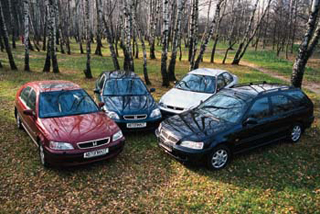Test drive Honda Civic Sedan 1995 - 2000 sedan
Variations on the topic
 The Japanese Honda Motor Co., Ltd., which once engaged exclusively with motorcycles, began to produce cars in 1964. And in this matter, I must say, succeeded, although it lags behind the total sales from its main competitors. But many manufacturers can only envy the popularity of some Honda models in the US and European markets. They include a small class of Honda Civic - practical, reliable and inexpensive.
The Japanese Honda Motor Co., Ltd., which once engaged exclusively with motorcycles, began to produce cars in 1964. And in this matter, I must say, succeeded, although it lags behind the total sales from its main competitors. But many manufacturers can only envy the popularity of some Honda models in the US and European markets. They include a small class of Honda Civic - practical, reliable and inexpensive. Honda Civic is sold around the world and with a variety of bodies, just no convertible - not the same class of a car. (Note that among numerous versions based on Civic, which are sold under other names, there are a convertible, and even all -wheel drive.) Produce a car - by countries and continents: in Japan, Europe, the USA, Canada.
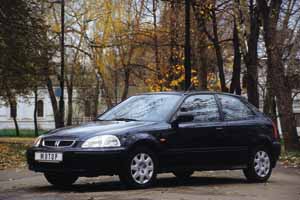 The widespread stability of demand for Civic can probably be explained by the fact that the current - sixth - generation of the car (the first appeared in 1972), the creators tried to make universal, satisfying the requirements of customers and Japan, and Europe, and the USA. And the requirements were completely different. Before the design, a survey was conducted around the world: what requires an improvement in the fifth generation Civic?. Japanese buyers in the first place put an increase in the efficiency of engines and the comfort of seats (!), European - a decrease in noise level and improvement of controllability, American - increasing tire walkers (?).
The widespread stability of demand for Civic can probably be explained by the fact that the current - sixth - generation of the car (the first appeared in 1972), the creators tried to make universal, satisfying the requirements of customers and Japan, and Europe, and the USA. And the requirements were completely different. Before the design, a survey was conducted around the world: what requires an improvement in the fifth generation Civic?. Japanese buyers in the first place put an increase in the efficiency of engines and the comfort of seats (!), European - a decrease in noise level and improvement of controllability, American - increasing tire walkers (?).  We decided to assemble Civic together with different bodies - this car is considered primarily practical, and practicality is mainly determined by the properties of the body. Two hatchbacks (3- and 5-door), a sedan and a station wagon- Japanese and English assembly were on our test. I also wanted to look at American products: in addition to Japanese, there is an American company - American Honda Motor Co., Inc., which not only sells, but also produces cars on its own. Each works on their own market, and they manufactured under the same names and it seems that the same machines have certain differences. In addition, American Honda has a luxury department - Acura Division, which produces and sells the same cars, but already under its own brand ...
We decided to assemble Civic together with different bodies - this car is considered primarily practical, and practicality is mainly determined by the properties of the body. Two hatchbacks (3- and 5-door), a sedan and a station wagon- Japanese and English assembly were on our test. I also wanted to look at American products: in addition to Japanese, there is an American company - American Honda Motor Co., Inc., which not only sells, but also produces cars on its own. Each works on their own market, and they manufactured under the same names and it seems that the same machines have certain differences. In addition, American Honda has a luxury department - Acura Division, which produces and sells the same cars, but already under its own brand ... It is impossible to understand the intricacies of the names and characteristics of the Honda car to an ordinary buyer - it is difficult. This is probably done specifically - so that he did not understand that the whole variety of the proposed models was made on two or three basic platforms. However, recently, many manufacturers working in different markets do this.
The American assembly Honda Civic failed to find in Moscow. True, a car with the name Acura El, which was claimed, was caught, and it was precisely what we needed. Frankly, we doubted - well, there is no analogue of Civic in the range of the American Acura: such a simple car is not for the luxury compartment.
The investigation, however, showed that we doubted in vain: Acura El still exists and is indeed an analogue of Honda Civic - not in the USA, but in Canada. (The country is simpler - it will do there ...)
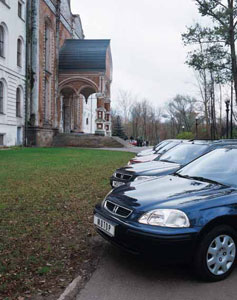 So, the kit is assembled. Note that the chirping name Civic is very suitable for this compact and nimble city car. It is urban: hanging wheels, breakdown of tires and other spectacular driving elements - not his topic. So, having placed the car in a natural environment for them, we simply participated in a fussy street movement. There was no much sense to identify differences in the behavior of machines with different bodies - if they are, then extremely insignificant, and outside the landfill, in ordinary city driving modes, are unlikely to appear. So it turned out ...
So, the kit is assembled. Note that the chirping name Civic is very suitable for this compact and nimble city car. It is urban: hanging wheels, breakdown of tires and other spectacular driving elements - not his topic. So, having placed the car in a natural environment for them, we simply participated in a fussy street movement. There was no much sense to identify differences in the behavior of machines with different bodies - if they are, then extremely insignificant, and outside the landfill, in ordinary city driving modes, are unlikely to appear. So it turned out ... Cars do not require long -term addiction. Their behavior on the road is quite predictable - without any hints of the originality of Norov. In the city hustle and bustle, all cars showed themselves easy to drive, dynamic and maneuverable. The sloping hood leaves a very small dead zone in front of the car, which helps to notice and go around road defects even in a dense flow of cars. The definition of lateral dimensions also does not cause problems. Plus, a very good circular review - thanks to the large area of \u200b\u200bbent glasses and thin racks: this quality will appreciate any driver. From unwanted contacts, thick rubber overlays on the sides are slightly protected. It is a little - they are too deeply drowned in the body.
The elastic suspension easily swallows asphalt defects, its characteristics practically exclude the rolls in corners. Particularly sharp, at high speeds, turns revealed a small tendency to demolish the front bridge - without loss, however, control over the machine. But this is an extreme mode, usually no one goes like that ... The power supply allows you to break away from the general flow on traffic lights and overtake leisurely fellow travelers, the anti -lock system is not too annoying.
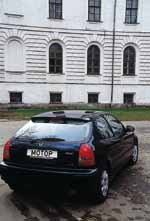 A few words about the design. Front -wheel drive cars. Each front wheel is suspended on two parallel transverse levers and a rack with springs. The rear ones have one longitudinal lever and a spring and three reactive rods. There are no reptile stabilizers.
A few words about the design. Front -wheel drive cars. Each front wheel is suspended on two parallel transverse levers and a rack with springs. The rear ones have one longitudinal lever and a spring and three reactive rods. There are no reptile stabilizers. 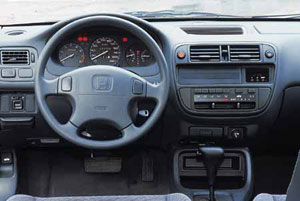 The steering is rack, with an amplifier that reduces its help with speed growth.
The steering is rack, with an amplifier that reduces its help with speed growth. Passive safety is provided by power boxes passing along the body, tubular elements in the doors, inflatable pillows and three -point adjustable seat belts - in front and back.
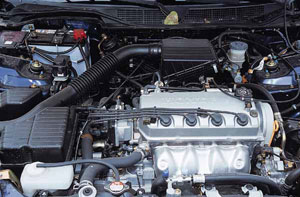 The set of power units offered for Civic is quite large. We tried several combinations of engines and boxes. All engines are four-cylinder, with aluminum blocks and heads, multi-point injection and 16-valve heads. Motors are suspended on five pneumatic supports - in order to reduce vibrations transferred to the body. Working volumes - 1.4, 1.5 and 1.6 liters, each has several options with different compression degrees, therefore, in principle, the consumer can choose a motor with a capacity of 75 to 160 hp. (even in the range there are 1.8 l of the 169-horsepower gasoline engine and 2 l 86-horsepower Rover turbodiesel).
The set of power units offered for Civic is quite large. We tried several combinations of engines and boxes. All engines are four-cylinder, with aluminum blocks and heads, multi-point injection and 16-valve heads. Motors are suspended on five pneumatic supports - in order to reduce vibrations transferred to the body. Working volumes - 1.4, 1.5 and 1.6 liters, each has several options with different compression degrees, therefore, in principle, the consumer can choose a motor with a capacity of 75 to 160 hp. (even in the range there are 1.8 l of the 169-horsepower gasoline engine and 2 l 86-horsepower Rover turbodiesel). The capacity of the engines of the vehicles that fell on the test was in the range of 90-127 hp, in urban conditions the difference in the behavior of cars with different power units was surprisingly small.
1.5 l of the engine of the English station wagon and 1.6 liters - the Canadian sedan is released in design: both have a VTEC gas distribution system with variable phases.
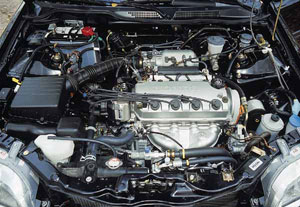 The work of the final valves pairs is unchanged at any revolutions and at any load, the intake operation of the intake is monitored by hydraulics, it is necessary to shift the fists of the alternating profile. As a result, at low speeds, the intake phases are narrow, the height of the lifting of one valve is small, the other opens a little more. With an increase in rotation frequency to 3000 rpm. The first valve begins to rise higher, and closer to 5000 rpm. Both are included in the work, increasing the height and time during which they are open to the maximum. Therefore, the diagram of the power dependence on the revolutions has several bursts - in the movement they correspond to tangible pickups, as if the second and then third respiration opens. In addition to excellent traction in various working modes, the VTEC system contributes to efficiency and a decrease in toxicity - due to the optimization of processes occurring in the cylinders.
The work of the final valves pairs is unchanged at any revolutions and at any load, the intake operation of the intake is monitored by hydraulics, it is necessary to shift the fists of the alternating profile. As a result, at low speeds, the intake phases are narrow, the height of the lifting of one valve is small, the other opens a little more. With an increase in rotation frequency to 3000 rpm. The first valve begins to rise higher, and closer to 5000 rpm. Both are included in the work, increasing the height and time during which they are open to the maximum. Therefore, the diagram of the power dependence on the revolutions has several bursts - in the movement they correspond to tangible pickups, as if the second and then third respiration opens. In addition to excellent traction in various working modes, the VTEC system contributes to efficiency and a decrease in toxicity - due to the optimization of processes occurring in the cylinders. A 5-speed mechanical box or 4-speed automatic-with electronic control and electronic adaptation system can be installed on Civic. There is a stranded transmission for Civic, but we did not come across a car with CVT.
Switching gears at the machine occur somewhere at 3500 rpm. By the way, when the revolutions are transplanted through this mark, the engine noise becomes well in the cabin - what is with an automatic machine, that with mechanics. There is nothing to be done, civic is not an accord ...
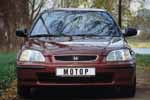 The main difference between the cars collected for the test from each other is in bodies. The silhouettes vary strongly - at first I can’t even believe that the cars have one platform.
The main difference between the cars collected for the test from each other is in bodies. The silhouettes vary strongly - at first I can’t even believe that the cars have one platform. 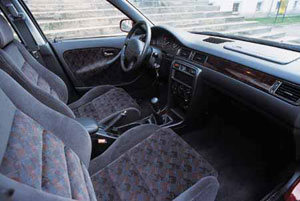 Cars have similar salons and equipment. The driver’s landing - regardless of the type of body - is the same.
Cars have similar salons and equipment. The driver’s landing - regardless of the type of body - is the same. All cars have electric windows and mirrors with electric drives. On the left on the torpedo there is a hydraulic clinic of the headlights. There are a central castle, immobilizer, a pair of airbags, built -in factory acoustic columns, a steering hydraulic power steering, an adjustable column, ABS and air conditioning, air flows from which are also masized by rear passengers.
The standard radio was found only on Acura El. With the exception of a small hatchback, sliding hatches with electric drive are cut into the roofs of all cars.
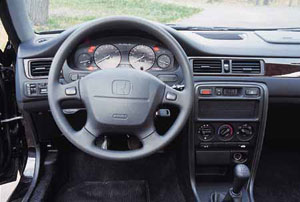 The dashboard of the machines are almost the same. Placed on plastic (in Acura - leather) torpedo buttons, switches and devices are equipped with a well -understandable symbol, and therefore the driver’s adaptation to the workplace occurs very quickly. The central place on the dashboard is occupied by two large round scales - a tachometer and a speedometer, a little smaller than the engine temperature indicators and fuel supply.
The dashboard of the machines are almost the same. Placed on plastic (in Acura - leather) torpedo buttons, switches and devices are equipped with a well -understandable symbol, and therefore the driver’s adaptation to the workplace occurs very quickly. The central place on the dashboard is occupied by two large round scales - a tachometer and a speedometer, a little smaller than the engine temperature indicators and fuel supply. Verse switches are familiar. Croxon buttons are close to the rim of the steering wheel, under the thumbs, which is acceptable when driving in a straight line and inconvenient when the steering wheel is turned.
 Three -door hatchback and four -door sedan
Three -door hatchback and four -door sedan Both cars were born in Japan. The three -door is the most compact car in the range, but this does not mean that it is cramped or inconvenient. Moreover, the car is much more spacious than its fifth -generation predecessor, who had a cropped wheelbase, compared to other machines of the series.
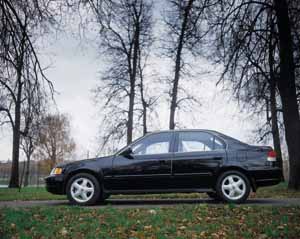 With chic, the salon does not shine. The velor front seats of both machines move back and forth, allow you to change the angles of installation of the pillow and back, which has weakly expressed side support. For the convenience of getting into the rear places, the right front chair after tilting the back to the torpedo leaves on the sleds far ahead. You can enter on the left, but it is less convenient.
With chic, the salon does not shine. The velor front seats of both machines move back and forth, allow you to change the angles of installation of the pillow and back, which has weakly expressed side support. For the convenience of getting into the rear places, the right front chair after tilting the back to the torpedo leaves on the sleds far ahead. You can enter on the left, but it is less convenient.  Sitting behind (including long -legged) passengers feel quite comfortable - there are soft niches in the backs of the front seats. True, if the growth of the rider exceeds 190 cm, its head will touch the ceiling (the roof of the sedan is slightly higher). If it is necessary to increase the volume of the luggage compartment or the placement of long objects of the back of the rear seats, both cars are leaned forward. In the trunk of the hatchback there is a cleaning shelf for mild objects.
Sitting behind (including long -legged) passengers feel quite comfortable - there are soft niches in the backs of the front seats. True, if the growth of the rider exceeds 190 cm, its head will touch the ceiling (the roof of the sedan is slightly higher). If it is necessary to increase the volume of the luggage compartment or the placement of long objects of the back of the rear seats, both cars are leaned forward. In the trunk of the hatchback there is a cleaning shelf for mild objects.  Five -door hatchback and station wagon
Five -door hatchback and station wagon Aerodeck station wagon appeared in the Civic gamut last, this year. Both cars were produced in the UK. The interior decoration is slightly richer than the machines described above - torpedo, for example, decorated with inserts for wood. The front seats have other adjustments - they can rise, get used to it, and the pillows no longer change the angle of their inclination. The side support of the backs is more embossed.
All four doors of the hatchback are equipped with electric windows, and only two (front) universals. Behind the height of its ceiling is noticeably larger than that of the rest of the tested machines. Tall passengers will be satisfied.
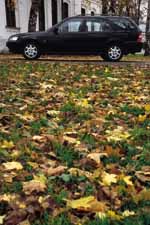 There are few changes in the mechanics, they are mainly in replacing the rear brake drums with disks.
There are few changes in the mechanics, they are mainly in replacing the rear brake drums with disks. Naturally, the main difference between the station wagon and other machines is the size of the luggage compartment. If necessary, you can increase its volume almost double - folding the backs of the rear seats, while their back side forms a smooth horizontal surface. The lower edge of the opening of the rear door is at the floor level - this makes convenient loading and unloading. However, this feature is inherent in all the bodies of Honda Civic ... The strict solidity of the silhouette of a black station wagon will surely appeal to business people.
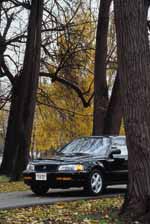 Acura El
Acura El Also sedan. Outwardly, the machine stands out from the group - it is the only one who has chrome moldings and cast wheels. American optics also look different.
Changes in mechanics - gas shock absorbers in the suspension. In addition, Canadians who love amenities are no less than Americans thoroughly worked on comfort and equipping the salon.
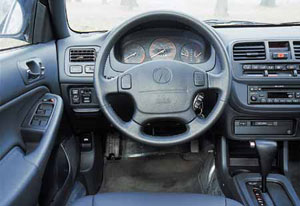 Inside the car, everything that is possible is covered with smooth black skin. The seats can be moved back and forth, tilt their backs. Side support is a little better than that of Japanese versions, but worse than that of English. But there is heated the front seats - in winter, leather upholstery is cooling well. She also found another drawback - slippery. Not only the fifth point glides - in the turns, but also the hands - along the steering wheel with speed steering, which when maneuvering in the city, when you catch millimeters, is fraught.
Inside the car, everything that is possible is covered with smooth black skin. The seats can be moved back and forth, tilt their backs. Side support is a little better than that of Japanese versions, but worse than that of English. But there is heated the front seats - in winter, leather upholstery is cooling well. She also found another drawback - slippery. Not only the fifth point glides - in the turns, but also the hands - along the steering wheel with speed steering, which when maneuvering in the city, when you catch millimeters, is fraught. All doors are equipped with electric windows, they are duplicated on the driver's door. There is a cruise control, very useful on the North American highways, alarm, a standard radio, which you can control without tearing your hands from the steering wheel, a compact doska player, a site for relaxation of the driver’s left leg ...
It seems that it is not such radical differences, but their combination makes the level of car comfort noticeably higher than that of its relatives.
 After meeting with the Honda Civic gamut, the popularity of this model around the world became clear. A practical, inexpensive (in the USA the base version costs a little more than $ 10,000, and the coolest is $ 18,000) a city car with a large set of engines, bodies ... There are a lot of configuration options - as a result. From a student to a middle -abandoned businessman, from a lonely to a burdened by a many -footed family - anyone can choose the appropriate Civic.
After meeting with the Honda Civic gamut, the popularity of this model around the world became clear. A practical, inexpensive (in the USA the base version costs a little more than $ 10,000, and the coolest is $ 18,000) a city car with a large set of engines, bodies ... There are a lot of configuration options - as a result. From a student to a middle -abandoned businessman, from a lonely to a burdened by a many -footed family - anyone can choose the appropriate Civic. And finally: one of the cars that visited us had 60 thousand km. During this collision in it, nothing broke and refused, and, by subjective sensation, with her behavior, she was no different from the new ones.
Alexey Strelkov
Source: Magazine Motor
Honda Civic Sedan 1995 test drives - 2000
Honda Civic Crash Test Sedan 1995 - 2000
Krassh Test: Detailed Information18%
Driver and passengers
3%
Pedestrians





